
Taking the proper steps to prepare your home for the cold can save you thousands on energy bills, minor repairs, and/or major repairs.
Winterizing your home can sometimes be a daunting and expensive endeavor, however.
Figuring on where to start and deciphering what are good investments versus what is not can be a difficult task.
The Good News? We are here to help.
This guide will go through all possible ways to prepare your home for the winter while keeping your hard-earned money in mind. We remove all the uncertainty from winterizing your home and give you an easy step by step guide to follow.
Before we get into the thick of the guide, check out our checklist:
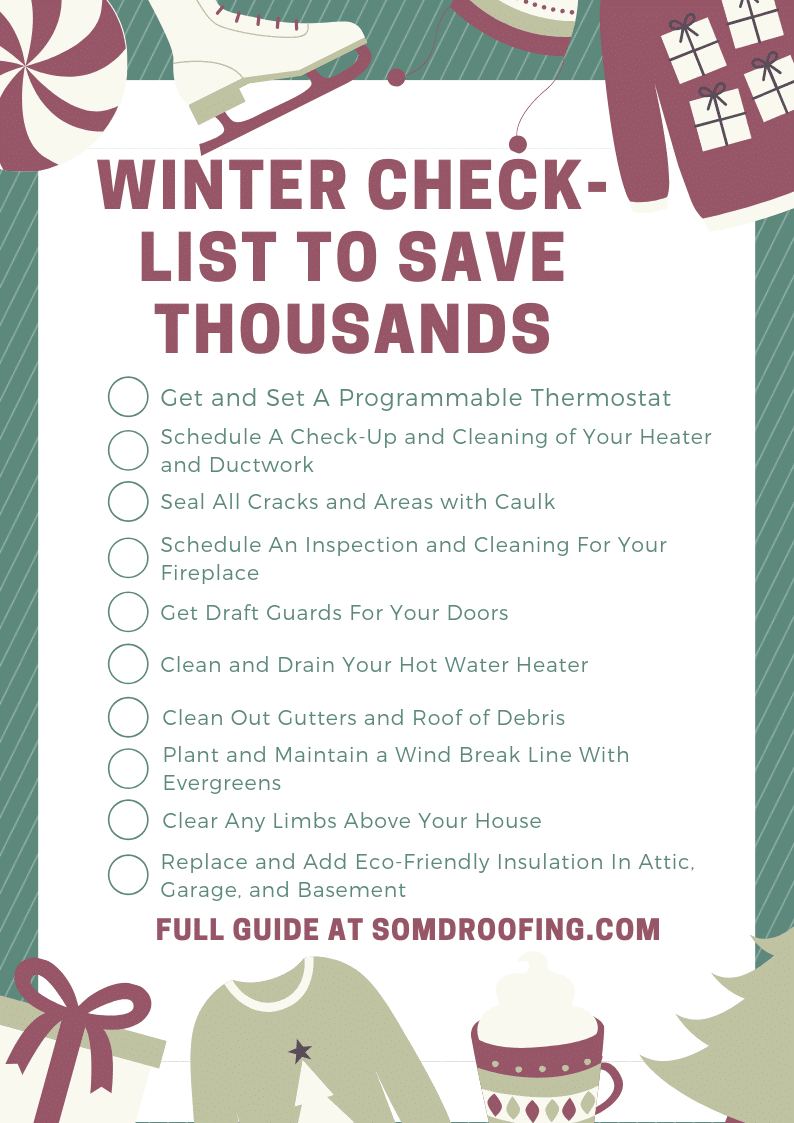
- Chapter 1: How To Winterize Your Home Without Spending Money
- Chapter 2: Budget Friendly Advice For Wallet
- Chapter 3: What Parts of Your Home Need TLC To Avoid Huge Money Pits
- Chapter 4: Energy-Efficient Tips and Tricks to Save On Your Energy Bills
- Chapter 5: Go Green; Family and Earth Friendly Ways To Get Ready For Winter
- Chapter 6: Avoid Roof Damage; Getting Your Roof Ready for the Cold
- Chapter 7: The Best of the Best; Our Must-Do List To Save You Money!
Chapter 1: How To Winterize Your Home Without Spending Money
Winterizing your house is extremely important to prevent major home repairs and save on energy bills.
But we know that money can be tight and therefore our first steps to help get your home ready for the winter do not involve you investing any money! These steps take time and effort but should save you from needing your wallet. Follow these steps below to start winterizing your home for free.
Step 1.) Drain Your Hot Water Heater
The bottom of your hot water heater will start to accumulate debris like soil and small particles. This build-up is not conductive and therefore it does not transfer heat. The more build-up you have, the more your hot water heater has to work to maintain temperature. This will end up costing you in gas or electricity depending on the top of hot waterer heater you have. By draining your hot water heater before winter you can get rid of the debris and keep your hot water heater running efficiently and saving you money.
Step 2.) Clean Your Gutters
We will go more in-depth with roof maintenance in Chapter 6 but cleaning your gutters does not cost you anything but time. By making sure that your gutters are free and clear of leaves and soil, you will prevent water and icy build-ups. Ice builds-ups might seem like a minor thing but are heavy and hard on your gutters. When ice gets heavy enough it can bend or warp your gutters and sometimes even unhinge causing your gutters fall from the roof. Water build-ups often lead to rust and coercion so even if you live in a mild winter climate, cleaning your gutters is still a smart idea.
Step 3.) Prepare and Clean Lawn Mowers and Gas Powered Lawn Care Equipment
Most of the time we store our lawnmowers and gas-powered lawn care equipment in a non-climate controlled area for the winter. While they might be shielded from the elements that does not protect them from the cold or corrosion. A thorough cleaning including removing all grass, dirt, and other organic material will prevent rust and keep your equipment from eroding. Also, almost everyone agrees leaving a full tank of gas in all your equipment is the best way to prevent engine issues when you first start up your equipment in the spring.
One last note is to make sure you clean all your equipment before winter or use a towel to get all the water off after you are done with the cleaning. Any water left, if cold enough, will still be on there when you bring your equipment out in the spring and you can expect rust because of it.
Step 4.) Lower Your Thermostat and Reverse Your Ceiling Fans
If you are like most of us during the summer months you have kept your thermostat at a higher temperature for your energy system to not work as hard to cool your house and to save on your energy bill. The winter is no different but the opposite way. Lower your thermostat to a temperature that you can bear and save on your heating bill.
To help your heating system you should also switch the way your ceiling fans spin. When your ceiling fans rotate clockwise they push air up. Hot air rises and sometimes can be trapped around your roofing and ceilings. When your ceiling fans push air up, they force the hot air downward giving your heating system some help that will save you money.
Taking advantage of these free money savers is a good start on your way to completely winterizing your home. In our next chapter, we tackle budget-friendly ways to take your winterizing skills to the next level.
Chapter 2: Budget Friendly Advice For Wallet
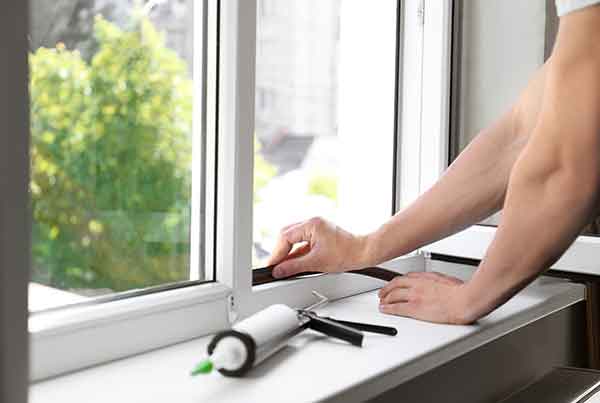 According to allconnect.com, a national study showed that energy leaks lead up to 20% more in costs on your energy bills. For the average American household that an additional $123 per month on energy bills.
According to allconnect.com, a national study showed that energy leaks lead up to 20% more in costs on your energy bills. For the average American household that an additional $123 per month on energy bills.
These next steps are budget-friendly tips to ensure you don’t end up paying that extra cost on your energy bills.
Step 1.) Window tape or weatherstrip tape all your window seals
Drafts and leaks are the main enemies to your energy efficiency and your energy bills. The most common place your house will have leaks and drafts are around your windows. Weatherstrip tape is designed to seal up your windows and not allow for any leaks or drafts.
The tape is extremely affordable only costing $5-$10 a roll and you can find the rolls at any local hardware store or on Amazon.
Step 2.) Use Window Insulation Film
There are a lot of different opinions about if window insulation film looks tacky but no one argues the effectiveness of the film. Most films you can buy on Amazon will keep up to 70% your heat from leaking out of your house.
Most of you are probably thinking that if you have already sealed your windows is the film necessary? Window insulation film is more effective on your energy bills and when combined with window tape, provides optimal results.
The reason the film is so effective is for two reasons: The first is the obvious one; any leak around your window seals will be covered up and protected by the film. The second is less obvious but still effective. When you install the film you don’t actually put it up against the window. That means when your warm air hits the film it has not been cooled down by the cold window panes keeping your air nice and warm on the inside.
Step 3.) Get Draft Guards For Your Doors
The next biggest energy leaks in your house come from underneath your doors. Draft guards will prevent your warm air from escaping your room or house while preventing the unwanted cold air from entering your house.
These guards can be made from a rolled towel at the bottom of your door or you can get nice looking guards for as cheap as $10 per on Amazon.
You can buy window insulation film on Amazon between $4-$22 depending on the kit.
Step 4.) Caulk your doors and cracks
The final step in protecting your home from unwanted drafts and leaks is to make sure your doors are doing what they should by keeping the elements and cold out. With the draft guards we took care of leaks and drafts from under the door but the sides of doors are just as prone to leaks.
Big cracks around the henges and in your outwalls will leak a ton of cold air. Fixing it is easy. Get a caulk gun and some caulk and seal up those money-draining cracks. At Home Depot you can get a caulk gun and tube of caulk for $8 and change.
These affordable and easy to do steps will keep your energy bills at a number you will be happy with. By doing all four of these steps you will spend around $100 dollars but the average person will save $132 a month. Over the course of a winter that is $330 dollars in savings!
Our next chapter we will show you how to save yourself money and winterize your home to avoid major repairs and pitfalls.
Chapter 3: What Parts of Your Home Need TLC To Avoid Huge Money Pits
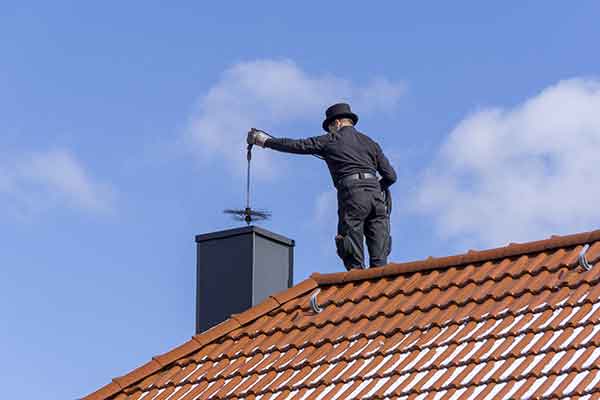 Year after year there is always so much to do to get ready for the winter that we often forget or skip preventative maintenance and focus on items that need to be fixed.
Year after year there is always so much to do to get ready for the winter that we often forget or skip preventative maintenance and focus on items that need to be fixed.
What we forget is that preventive maintenance over the long run can save you thousands and ensure you and your family are safe. Below are some of our best preventative maintenance items that you should take care of before winter hits.
Furnaces
If you are getting ready for the winter then it is mostly that your furnace has not been ran in over 3-6 months at your house. During that time a lot of dust, particles, and even water could have built up inside your furnace.
According to the AARP, yearly maintenance on your furnace before you fire it up for the first time during the winter season prevents fires, saves on expensive cleanups, and keeps your furnace running 5-10 years longer than those not serviced.
The average new furnace installed costs an average of $2,500, so calling a professional for yearly maintenance to the tune of $150 bucks is a no brainer. A maintenance call almost always includes new filters as well which will save you money over the winter on your energy bills.
Bottom Line- Spend $150 dollars on preventative care to stay safe and save $2,500 repair bill + savings on your energy bill.
Ductwork
Keeping in line with the heating and furnace theme, you need to give your ductwork some TLC too. The AARP estimates that faulting ductwork leads to 20% of your furnaces hot air to be wasted. Make sure all your ductwork is properly sealed at connections and pay to have it cleaned and repaired if needed.
Even more worrisome is if your ductwork is blocked or full of dust and ignitable particles which could cause you could have a very scary situation with your furnace. If your systems burners get dirty they will not burn properly. When the burners are not working properly gas can build up inside your furnace and when your burners finally do ignite cause a mini, and in some cases large, explosion.
Bottom Line- Cleaning, Repairing, and Maintaining your ductwork will save you money on your energy bills and keep you and your family safe from dust build-up in your heating system.
Fireplaces and Chimneys
A place you often forget to give some attention to before the winter starts is your fireplace and chimney. Having your chimney professional inspected and repaired every 2-3 years if you use your fireplace regularly will save you on electrical bills and keep you safe.
If your fireplace is not properly cleaned before the first time you use it, the smoke and CO2 could be blocked from leaving the chimney and leak back into your house. Cracks and foundation issues not only are safety concerns but also lead to leaks and drafts into the house.
For those of you who rarely use your fireplace, it is recommended that you put a chimney stopper up your chimney to prevent drafts and cold air from coming in your home. These draft stoppers are a typically a balloon that you inflate once you have it up the chimney to block cold airflow.
Bottom Line- Preventative and Yearly Inspections will keep you safe from fire damage, smoke damage, and CO2 poisoning while saving you on your energy bills.
These steps will help you avoid some major repair costs while keeping your family safe. While they seem like no brainers and easy-to-do, they often go forgotten or are skipped. These parts of your house need your attention and are a smart investment when it comes to preventive care.
Chapter 4: Energy-Efficient Tips and Tricks to Save On Your Energy Bills
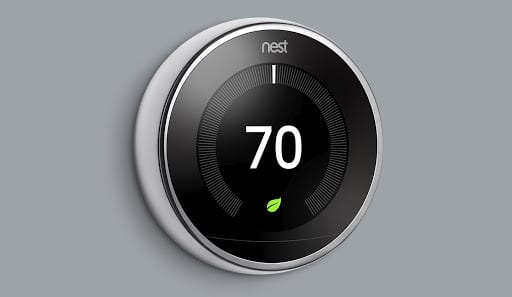
Tip 1.) Invest in a programmable thermostat
For every degree you keep your home lower during the winter, the department of energy says you will save 1-2% on energy bills. A programmable thermostat will allow you to lower your home’s temperature during the hours you are not home like when you are at work or on vacation.
Another option to consider is most American’s sleep under the covers and like it cooler at night compared to when they are awake and occupying the home. Play around with cooler temps while you are sleeping to save even more money.
Tip 2.) Get new and better Insulation
Insulation will keep your house warm and the cold air outside. Some of the best places to make sure you have high-quality insulation is above unfinished and non-temp controlled basements, your attic, and garages.
Other areas you might consider adding or improving insulation is around ac units, in rooms almost always unoccupied, and any unfinished room or area in your house. Basically, if you can go without heating an area cut it off from your heating system and insulate it!
Tip 3.) Seal your basement leaks
Even if you choose to leave your basement cold and do not heat it up, you should always seal any possible air leaks in your basement. Caulking is the best way to go to seal any cracks, joints, window seals, and other airs that might be leaking in cold air.
Remember, the more cold air you keep out of your basement the less your insulation has to work, the less your heating system has to work, and the easier it is to maintain temperatures throughout your house. This consistency will keep you happy and avoid any spikes on your energy bills.
Tip 4.) Invest in and use an infrared thermometer
These handy little tools are designed to test the temperature levels wherever you point the device. Depending on the model, you will be able to see the surface temperature, get indications of cold or hot air drafts, and indications on possible energy leaks.
Take your infrared around your house; check walls, windows, doors, joints, your attic, basement, and garage areas. If you find a leak use one of the tips above to stop the leak and insulate your house. Finding leaks and keeping your house energy efficient is the best way to save this winter on your energy bills.
Chapter 5: Go Green; Family and Earth Friendly Ways To Get Ready For Winter
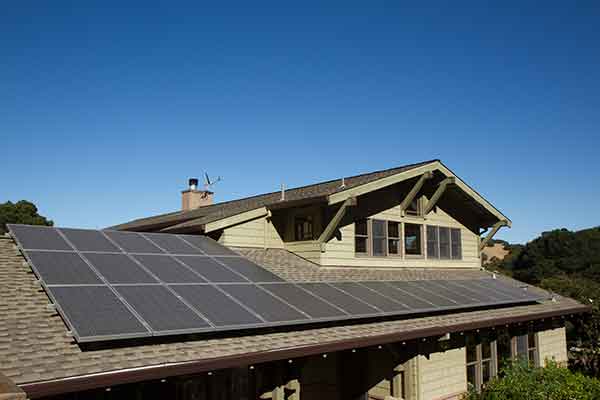
This chapter is all about winterizing your home while keeping away from the poisons, plastics, and one-use items. We know the growing concern for our kids and mother earth and this chapter is all about alternatives that will not harm your family or the environment.
- Stitch or buy quilted curtains for your windows. Windows are cold because of the glass. A nice thick quilted curtain will not only help insulate your house but can look great. Once you are through winter, you can reuse the fabric to make a quilt or other items.
- Install a permanent furnace filter. A permanent filter will take some extra time to clean and maintain but stops the waste of single-use filters.
- Use an insulating blanket for your hot water heater to keep it warmer and use less energy. For more on how to do this or how to make one check out this video from Seirra Club.
- Use your fireplace if you have one. We have gone over all the ways to insulate your house so now take advantage to let your fireplace do all the work of keeping your house warm.
- Do not shy away from solar power panels. Most people believe they cannot use solar power because they have too cold of winters. What many people do not realize is that the cold weather actually helps the panels become more efficient and improve output.
- Plant evergreens around your property close to your house. This creates a windbreak that can save you up to 30% in energy costs and help the environment with more plants.
- Cellulose and spray foams can help insulate your house without the waste that traditional fiberglass insulation creates. Cellulose and spray foams do not harm your family with particles in the air like other types of insulation as well.
- Your garage can be kept warm by using a solar heater. The fine people at how stuff work have an in-depth DIY guide on how to turn your garage into a passive solar heater here.
These earth and family-friendly tips can save you money and keep your house warm without harming effects of other options. It is important to keep your house warm but it is even more important to keep your family and our planet safe too.
Chapter 6: Avoid Roof Damage; Getting Your Roof Ready for the Cold
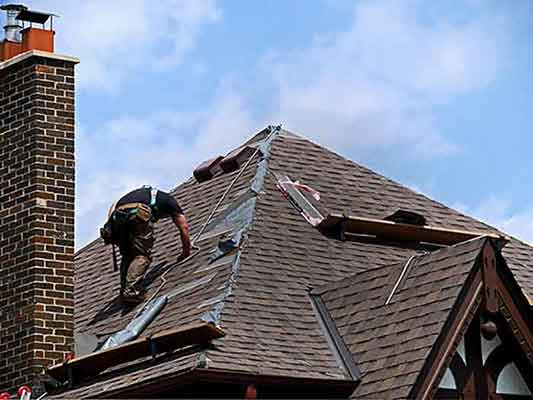 Your roof is the first line of defense in the winter from water, snow, wind, and cold. Keeping it free from damage is essential for the safety of your family and to save on your energy bills.
Your roof is the first line of defense in the winter from water, snow, wind, and cold. Keeping it free from damage is essential for the safety of your family and to save on your energy bills.
As a Southern Maryland roofing company, we know that roof repair can be expensive and in the winter are even more difficult to fix. It is far better to be prepared for the winter than to be scrambling to fix issues in the cold and snow. Here is our list to ensure your roof is ready to take on the winter elements and keep your family protected.
Schedule an inspection
Roofing professionals now can use advanced equipment like drones to help with the inspection process. Roofing professionals have a trained eye to look for loose shingles, check for open or loose seems, find any gaps or separations, and to look for punctures in your roof’s membrane. Having an inspection can catch small issues and faults before they become a big issue later. To get started, contact a local roofer that gives free estimates and has good reviews.
Clean everything off your roof and gutters
Anything that you do not have cleared from your roof before the winter could be stuck there for a very long time. Organic material can decompose and rot under snow and ice causing issues with your singles or worse membrane.
Cleaning out your gutters and clearing your roof of leaves, limbs, and nests will prevent these materials from hurting your roof during the winter.
Clear any limbs hanging over your house- Winter brings ice and snow and that can be heavy for limbs. Walk your property line looking up and assuming every limb has the chance to fall. The last thing you want this winter is a cold, wet, icy, and heavy limbs falling on or through your roof into your house.
Seal All Your Pipes and Wires
Often times we install new gadgets and gizmos on the roof and don’t properly seal them. Getting on your roof and checking around your chimney, any wiring, and any appliances (satellite dish, solar panels, etc) can save you a ton of money on energy bills and keep your roof around these areas safe.
Check Your Attic
Last but not least is to check your attic. This will let you see the underbelly of your roof. Look for any loose materials that might need to be refastened or replaced. You are also looking for any signs of water that would indicate a leak in the roof.
Don’t forget to check the insulation in your attic. Not only does it keep your house warm but if you are leaking heat up to your roof often times this leads to ice and water issues. The hot and cold go both ways and insulation is the best way of protecting the roof and house.
Preparing your roof for the winter is extremely important. It does not just save you on your energy bills but saves you from spending thousands on large roofing repairs down the road.
Chapter 7: The Best of the Best; Our Must-Do List To Save You Money!
If you have made it this far that means one of two things: You have skimmed all the way to get here or you have read through all 30+ tips we have given you to help winterize your home. Either way, this chapter is all about keeping it short and simple.
If there are any takeaways from this article these should be it. These are our top ten tips to save you the most money this winter!
- Get and Set A Programmable Thermostat
- Schedule A Check-Up and Cleaning of Your Heater and Ductwork
- Seal All Cracks and Areas with Caulk
- Schedule An Inspection and Cleaning For Your Fireplace
- Get Draft Guards For Your Doors
- Clean and Drain Your Hot Water Heater
- Clean Out Gutters and Roof of Debris
- Clear Any Limbs Above Your House
- Plant and Maintain a Wind Break Line With Evergreens
- Replace and Add Eco-Friendly Insulation In Attic, Garage, and Basement
We hope you enjoyed our guide. These techniques and tips have helped many people save thousands over the years and can help you save too. Think we missed something or want to chat about something in the guide? Feel free to leave a comment below in the comment section!

